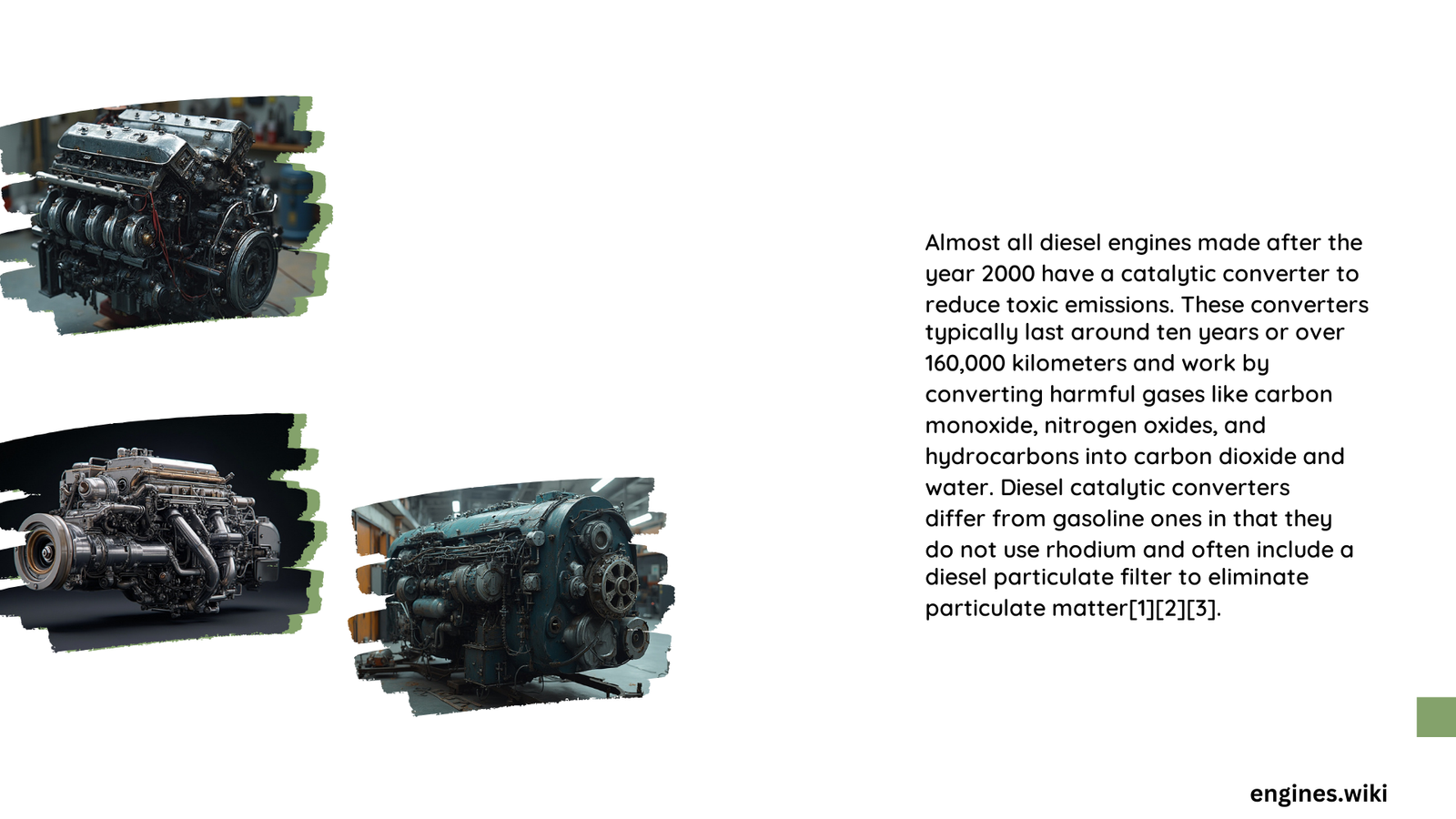Diesel engines are equipped with catalytic converters to reduce harmful emissions and comply with environmental regulations. Modern diesel vehicles utilize specialized catalytic systems, including Diesel Oxidation Catalysts (DOC) and Diesel Particulate Filters (DPF), to effectively control pollutants. This article explores the presence, function, and necessity of catalytic converters in diesel engines, addressing common questions and misconceptions.
Do All Diesel Engines Have Catalytic Converters?
The presence of catalytic converters in diesel engines has evolved over time, primarily driven by increasingly stringent emissions regulations. Here’s a breakdown of the implementation:
- Pre-1990s: Most diesel engines did not have catalytic converters.
- 1990-2000: Catalytic converters began to be introduced in some diesel models.
- Post-2000: Nearly all diesel engines are equipped with catalytic converters to meet emissions standards.
What Are the Exceptions?
While the majority of modern diesel engines have catalytic converters, there are some exceptions:
- Older models (pre-1990s)
- Some heavy-duty or off-road diesel engines
- Certain marine diesel engines
It’s important to note that even if a diesel engine doesn’t have a traditional catalytic converter, it may still employ other emissions control technologies.
How Do Catalytic Converters Work in Diesel Engines?

Diesel catalytic converters function differently from those in gasoline engines due to the unique characteristics of diesel combustion. The primary components are:
- Diesel Oxidation Catalyst (DOC)
- Diesel Particulate Filter (DPF)
What Does a Diesel Oxidation Catalyst Do?
The DOC is the first line of defense in the diesel emissions control system. It performs several crucial functions:
- Oxidizes carbon monoxide (CO) to carbon dioxide (CO2)
- Converts hydrocarbons (HC) to water and CO2
- Reduces particulate matter (PM) emissions
Chemical Reactions in a DOC
| Pollutant | Reaction | Result |
|---|---|---|
| Carbon Monoxide | CO + ½O₂ → CO₂ | Carbon Dioxide |
| Hydrocarbons | HC + O₂ → CO₂ + H₂O | Carbon Dioxide and Water |
How Does a Diesel Particulate Filter Work?
The DPF works in conjunction with the DOC to further reduce particulate matter emissions:
- Traps soot and other particulates in its honeycomb structure
- Periodically burns off accumulated particulates through a process called regeneration
- Can capture up to 99% of particulate matter under optimal conditions
When Were Catalytic Converters Introduced in Diesel Engines?
The timeline for the introduction of catalytic converters in diesel engines varies by region and manufacturer:
- 1990s: Early adoption in some diesel models
- 2000s: Widespread implementation due to tightening emissions standards
- 2010: Most light-duty diesel manufacturers in the U.S. added catalytic systems to meet federal requirements
What Prompted the Introduction of Diesel Catalytic Converters?
Several factors led to the adoption of catalytic converters in diesel engines:
- Increasing awareness of air pollution and its health impacts
- Stricter government regulations on vehicle emissions
- Advancements in catalytic converter technology for diesel applications
- Public demand for cleaner, more environmentally friendly vehicles
Are Diesel Catalytic Converters Different from Gasoline Ones?
Yes, diesel catalytic converters differ from those used in gasoline engines in several ways:
| Aspect | Diesel Catalytic Converter | Gasoline Catalytic Converter |
|---|---|---|
| Primary Function | Oxidation of CO and HC, PM reduction | Three-way catalysis (CO, HC, NOx reduction) |
| Operating Temperature | Lower (150-400°C) | Higher (400-800°C) |
| Catalyst Materials | Primarily platinum and palladium | Platinum, palladium, and rhodium |
| Additional Components | Often includes DPF | Typically standalone |
What Are the Benefits of Catalytic Converters in Diesel Engines?
The implementation of catalytic converters in diesel engines offers several significant benefits:
- Reduced Emissions: Catalytic converters significantly decrease harmful pollutants, including:
- Up to 90% reduction in carbon monoxide
- Up to 90% reduction in hydrocarbons
-
Substantial reduction in particulate matter
-
Improved Air Quality: By reducing emissions, diesel catalytic converters contribute to better overall air quality, especially in urban areas.
-
Compliance with Regulations: Catalytic converters help diesel vehicles meet increasingly stringent emissions standards worldwide.
-
Enhanced Engine Performance: Some modern catalytic converter systems can improve fuel efficiency and engine performance.
What Challenges Do Diesel Catalytic Converters Face?
Despite their benefits, diesel catalytic converters also present some challenges:
- Cost: Diesel catalytic converters can be expensive to manufacture and replace.
- Maintenance: Regular maintenance is required to ensure optimal performance.
- Sulfur Sensitivity: High sulfur content in diesel fuel can damage catalytic converters.
- Cold Start Emissions: Diesel catalytic converters are less effective during cold starts.
How Can These Challenges Be Addressed?
To overcome these challenges, manufacturers and researchers are exploring several solutions:
- Development of more durable and cost-effective catalyst materials
- Implementation of advanced engine management systems
- Promotion of ultra-low sulfur diesel fuel
- Integration of additional emissions control technologies, such as Selective Catalytic Reduction (SCR)
In conclusion, diesel engines do have catalytic converters, which play a crucial role in reducing harmful emissions and meeting environmental regulations. As technology continues to advance, we can expect further improvements in diesel emissions control systems, contributing to cleaner and more efficient diesel engines.
